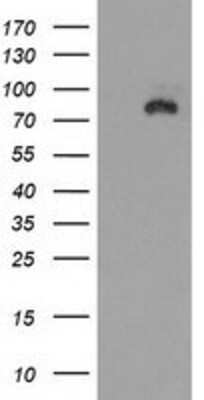SAP102 Products
Synapse-Associated Protein 102 (SAP102) is one of a family of plasma membrane-associated proteins found in synaptic junctions. Like other members of the family, SAP102 has three ~90 amino acid repeats called PDZ domains followed by an SH3 domain and a yeast guanylate kinase homology (GuK) domain. It is hypothesized that PDZ-domain interactions play a role in receptor and channel clustering which contributes to neuronal plasticity. SAP102 is believed to participate in the clustering of certain proteins, including NMDA receptors, shaker-type potassium channels at the synaptic membrane in CNS neurons. NMDA receptors and Shaker-type potassium channels both share C-terminal sequence homology consisting of a threonine/serine-X-valine-COOH (T/SXV) motif. Other neuronal proteins that share this motif (beta 1 adrenergic receptor, some serotonin receptors, some sodium channel subunits, and additional potassium channel subunits) may interact with SAP102 by binding to its PDZ domains. Neuronal nitric oxide synthase (nNOS), which lacks the T/SXV motif but which has its own PDZ domain, has been shown to associate with SAP102 in vitro through a pseudo-homotypic PDZ-PDZ interaction.
Show More
14 results for "SAP102" in Products
14 results for "SAP102" in Products
SAP102 Products
Synapse-Associated Protein 102 (SAP102) is one of a family of plasma membrane-associated proteins found in synaptic junctions. Like other members of the family, SAP102 has three ~90 amino acid repeats called PDZ domains followed by an SH3 domain and a yeast guanylate kinase homology (GuK) domain. It is hypothesized that PDZ-domain interactions play a role in receptor and channel clustering which contributes to neuronal plasticity. SAP102 is believed to participate in the clustering of certain proteins, including NMDA receptors, shaker-type potassium channels at the synaptic membrane in CNS neurons. NMDA receptors and Shaker-type potassium channels both share C-terminal sequence homology consisting of a threonine/serine-X-valine-COOH (T/SXV) motif. Other neuronal proteins that share this motif (beta 1 adrenergic receptor, some serotonin receptors, some sodium channel subunits, and additional potassium channel subunits) may interact with SAP102 by binding to its PDZ domains. Neuronal nitric oxide synthase (nNOS), which lacks the T/SXV motif but which has its own PDZ domain, has been shown to associate with SAP102 in vitro through a pseudo-homotypic PDZ-PDZ interaction.
Show More
Applications: IHC, WB
Reactivity:
Human
| Reactivity: | Human |
| Details: | Rabbit IgG Polyclonal |
| Applications: | IHC, WB |
| Applications: | WB, ELISA, MA, AP |
Applications: IHC, WB, ELISA
Reactivity:
Human,
Mouse,
Rat
| Reactivity: | Human, Mouse, Rat |
| Details: | Rabbit IgG Polyclonal |
| Applications: | IHC, WB, ELISA |
| Reactivity: | Mouse, Rat |
| Details: | Rabbit IgG Polyclonal |
| Applications: | IHC, WB |
Applications: WB, Flow
Reactivity:
Human,
Mouse,
Rat
| Reactivity: | Human, Mouse, Rat |
| Details: | Mouse IgG1 Monoclonal Clone #OTI3F2 |
| Applications: | WB, Flow |
| Reactivity: | Human |
| Details: | Rabbit IgG Polyclonal |
| Applications: | WB, ICC/IF |
| Reactivity: | Human |
| Details: | Mouse IgG2a Kappa Monoclonal Clone #2B6 |
| Applications: | WB, ELISA, KD |
| Applications: | ELISA |
| Applications: | ELISA |
| Applications: | AC |
Applications: WB, Flow, CyTOF-ready
Reactivity:
Human,
Mouse,
Rat
| Reactivity: | Human, Mouse, Rat |
| Details: | Mouse IgG1 Monoclonal Clone #OTI3F2 |
| Applications: | WB, Flow, CyTOF-ready |
Applications: WB, Flow, CyTOF-ready
Reactivity:
Human,
Mouse,
Rat
| Reactivity: | Human, Mouse, Rat |
| Details: | Mouse IgG1 Monoclonal Clone #OTI3F2 |
| Applications: | WB, Flow, CyTOF-ready |
Applications: WB, Flow
Reactivity:
Human,
Mouse,
Rat
| Reactivity: | Human, Mouse, Rat |
| Details: | Mouse IgG1 Monoclonal Clone #OTI3F2 |
| Applications: | WB, Flow |
Applications: WB, Flow
Reactivity:
Human,
Mouse,
Rat
| Reactivity: | Human, Mouse, Rat |
| Details: | Mouse IgG1 Monoclonal Clone #OTI3F2 |
| Applications: | WB, Flow |

![Western Blot: SAP102 Antibody [NBP1-87691] Western Blot: SAP102 Antibody [NBP1-87691]](https://resources.bio-techne.com/images/products/SAP102-Antibody-Western-Blot-NBP1-87691-img0007.jpg)

![Western Blot: SAP102 Antibody [NBP3-35258] - SAP102 Antibody](https://resources.bio-techne.com/images/products/nbp3-35258_rabbit-sap102-pab-91220241581246.jpg)
![Western Blot: SAP102 Antibody [NB100-2063] Western Blot: SAP102 Antibody [NB100-2063]](https://resources.bio-techne.com/images/products/SAP102-Antibody-Western-Blot-NB100-2063-img0003.jpg)

![Western Blot: SAP102 Antibody [NBP2-58864] Western Blot: SAP102 Antibody [NBP2-58864]](https://resources.bio-techne.com/images/products/SAP102-Antibody-Western-Blot-NBP2-58864-img0002.jpg)
![Western Blot: SAP102 Antibody (2B6) [H00001741-M03] Western Blot: SAP102 Antibody (2B6) [H00001741-M03]](https://resources.bio-techne.com/images/products/SAP102-Antibody-2B6-Western-Blot-H00001741-M03-img0003.jpg)
![ELISA: Human SAP102 ELISA Kit (Colorimetric) [NBP3-31432] - Human SAP102 ELISA Kit (Colorimetric)](https://resources.bio-techne.com/images/products/nbp3-31432_human-sap102-elisa-kit-colorimetric-206202415314850.png)
![ELISA: Human SAP102 - Ready-To-Use ELISA Kit (Colorimetric) [NBP3-31433] - Human SAP102 - Ready-To-Use ELISA Kit (Colorimetric)](https://resources.bio-techne.com/images/products/nbp3-31433_human-sap102-ready-to-use-elisa-kit-colorimetric-206202415294076.png)

![SAP102 Antibody (OTI3F2) [mFluor Violet 450 SE] [NBP2-73985MFV450] -](https://resources.bio-techne.com/images/products/nbp2-73985mfv450_mouse-sap102-mab-oti3f2-mfluor-violet-450-se-2262023131775.png)